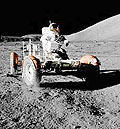This Day in History: December 14, 1972
Additional Date: December 14, 1972
The first phase of humankind's active exploration of the Moon came to an end when Apollo 17's lunar module left the lunar surface on December 14, 1972. A total of twelve men had walked on the Moon since Neil Armstrong stepped out of Apollo 11 in July 1969.
While astronaut's Eugene Cernan and Harrison Schmitt descended in the Lunar Module (LM) "Challenger" to explore the Moon, astronaut Ronald E. Evans, command module pilot, remained with the Command and Service Modules (CSM) "America" in lunar-orbit. While on the moon, Cernan and Schmitt, engaged in three moonwalks for a total of 22 hours and 2 minutes.
Ceran and Schmitt completed their third lunar walk after a short ceremony in which they bade farewell to the Moon and unveiled a small commemorative plaque at the Taurus-Littrow valley. On it was written, "Here man completed his first explorations of the Moon, December 1972." Eugene Cernan also read out loud the postscript: "May the spirit of peace in which we came be reflected in the lives of all mankind."
Apollo 17 conducted more hard science than the previous Moon missions, and is fondly remembered for its lasting contributions to our knowledge of the Moon's geology and history. Commander Cernan and Dr Schmitt, the first trained geologist in space, gathered more material than ever before, spent longer on the surface and drove further away from the landing craft than in any previous Apollo mission. They also set up six automatic scientific research stations. Arguably the mission's most important discovery was that of an orange coloured soil found at the rim of a crater, suggesting that there had once been volcanic activity on the Moon's surface.
Although Apollo 17 marked the end of US missions to the Moon, NASA continued to develop space exploration. Skylab, the first US space station, was launched in 1973. It was a continuation of the Apollo programme and housed three different Apollo crews. The last Skylab crew left orbit in 1974, while Skylab itself fell back to Earth in 1979, some years earlier than expected, disintegrating in the skies over Western Australia.
NASA also developed the space shuttle, launched for the first time in 1981. More recently, space exploration has focussed on unmanned missions to Mars and beyond, and on the construction of the International Space Station.
In January 2004 US President, George Bush, proposed that American astronauts return to the Moon by 2020 as the launching point for missions further into space.
